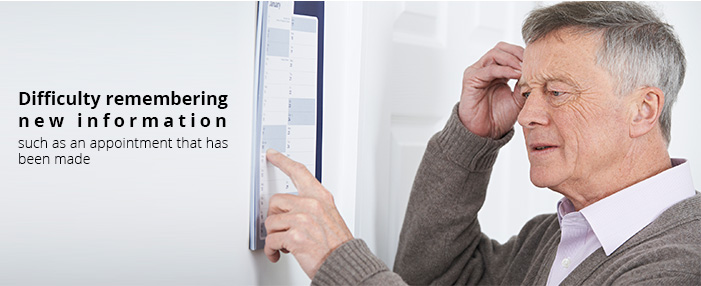Alzheimer’s is the most frequent cause of age-related cognitive decline. 30 million people are affected globally and it is likely to be 160 million by 2050.

Every day our brain routinely stores the information we need to remember and loses what we do not need to retain. For instance, we remember meeting a new colleague but forget the details of the journey to work. As we age, it is common to take longer to remember things but there are certain pointers that indicate the problem is more than just natural ageing and is indicative of a disease process.
 The most common symptom of Alzheimer’s is difficulty remembering new information, such as an appointment that has been made. While people who are ageing normally may also forget things, they typically remember them later – in other words, they remember that they forgot. But in Alzheimer’s disease this doesn’t happen. An affected person will forget something and never retrieve the information; nor does it seem familiar when reminded.
The most common symptom of Alzheimer’s is difficulty remembering new information, such as an appointment that has been made. While people who are ageing normally may also forget things, they typically remember them later – in other words, they remember that they forgot. But in Alzheimer’s disease this doesn’t happen. An affected person will forget something and never retrieve the information; nor does it seem familiar when reminded.
It normally gets worse over time, although symptoms vary greatly. The first thing people notice is forgetfulness, severe enough to affect their ability to function at home or at work or to enjoy hobbies. Or it might be noticed by a family member or friend that a person is becoming increasingly forgetful. The disease may cause a person to become confused, lost in familiar places, to misplace things or have trouble with language, show poor judgement and have mood and personality changes.
Alzheimer’s has been considered a disease associated with ageing. However, these changes to the brain can also occur in younger people – for example in Mexico City some children and young adults with chronic exposures to high levels of ozone and particulate matter (from pollution) are showing brain changes associated with Alzheimer’s.
Alzheimer’s is the most common cause of dementia. But there are other types of dementia including vascular dementia, mixed dementia, Parkinson’s disease dementia, Lewy Body, Huntingdon’s disease, Creutzfeldt-Jakob disease, frontotemporal dementia, normal pressure hydrocephalus, Down’s syndrome dementia, Korsakoff psychosis, posterior cortical atrophy etc.
 If you are concerned about your risk of brain decline now or in the future, perhaps because you have noticed brain fog, poor memory or concentration or maybe you have a family member diagnosed with dementia, then you might be interested in attending an AAA introductory talk to find out more about the dietary and lifestyle choices you could adopt that have been shown in research to support brain health.
If you are concerned about your risk of brain decline now or in the future, perhaps because you have noticed brain fog, poor memory or concentration or maybe you have a family member diagnosed with dementia, then you might be interested in attending an AAA introductory talk to find out more about the dietary and lifestyle choices you could adopt that have been shown in research to support brain health.